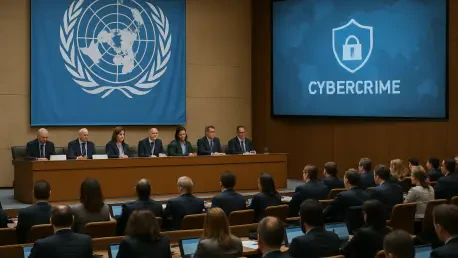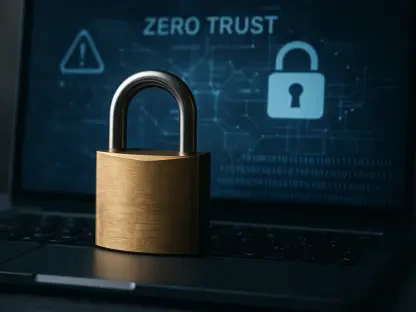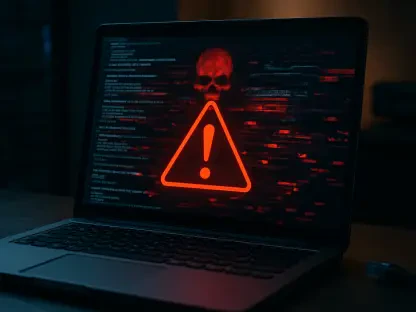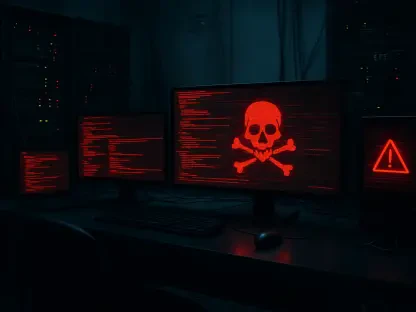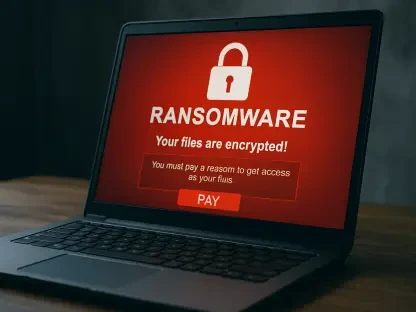In an era where digital threats loom larger than ever, consider the staggering reality that cybercrime costs the global economy over $8 trillion annually, with attacks becoming more sophisticated by the day, underscoring the urgent need for a unified response to online crime. This alarming statistic highlights a challenge the United Nations has tackled head-on with its groundbreaking Convention against Cybercrime. Signed by 72 nations in a historic ceremony, this treaty marks the world’s first global agreement aimed at combating digital offenses, promising to reshape how countries collaborate in a hyper-connected landscape. This review delves into the Convention’s key features, evaluates its potential to revolutionize international justice, and examines the controversies that threaten to undermine its impact.
Key Features of the Global Agreement
Strengthening Cybercrime Prevention and Response
At the heart of this international treaty lies a commitment to bolster global efforts in preventing and combating cybercrime through standardized approaches. The framework seeks to harmonize legal definitions and responses to digital threats, ensuring that crimes such as hacking, data theft, and online fraud are addressed with consistent rigor across borders. This uniformity aims to close gaps that cybercriminals often exploit when operating in jurisdictions with differing laws.
Beyond legal alignment, the Convention pushes for enhanced cybersecurity measures, encouraging nations to adopt robust policies and technologies to deter online crime. By establishing a baseline for prevention, the agreement hopes to reduce the incidence of attacks that plague both individuals and critical infrastructure. This proactive stance is particularly crucial as digital dependency continues to grow worldwide.
Enabling Cross-Border Collaboration
One of the standout provisions of the treaty is its emphasis on international cooperation, particularly through mechanisms for sharing digital evidence across jurisdictions. This feature addresses a longstanding hurdle in prosecuting cybercrimes, where perpetrators, victims, and data are often scattered across multiple countries, complicating investigations. The streamlined process for evidence exchange is designed to accelerate legal proceedings and improve conviction rates.
This collaborative framework also facilitates joint operations and information-sharing among law enforcement agencies globally. By breaking down bureaucratic barriers, the treaty aims to create a more agile response to transnational cyber threats. Such innovation holds the promise of transforming how justice is served in the digital realm, making accountability less elusive for offenders.
Technical Support and Capacity Development
Recognizing disparities in technological readiness, the Convention includes provisions for technical assistance and capacity-building, with a focus on supporting developing nations. This aspect ensures that countries with limited resources receive training, tools, and expertise to build resilient cybersecurity infrastructures. The goal is to level the playing field, enabling all signatories to effectively combat online threats.
This commitment to empowerment extends to fostering partnerships between nations, allowing for the transfer of knowledge and best practices. By equipping less-prepared countries with the means to defend against digital attacks, the treaty seeks to create a more secure global internet ecosystem. Such inclusivity is vital for ensuring that no region becomes a weak link in the fight against cybercrime.
Performance and Reception on the Global Stage
Widespread International Endorsement
The treaty’s signing ceremony saw an impressive turnout, with 72 nations committing to the agreement on the first day, reflecting strong global support for its objectives. The diversity of signatories, spanning countries like China, Australia, Spain, Peru, South Africa, and Iran, highlights a broad geographic and political consensus on the urgency of addressing cyber threats. This wide backing signals a collective recognition of the need for a unified front.
Although a complete list of signatories remains unavailable, the initial response suggests a significant step toward global alignment on digital security. The participation of nations with varying economic and political landscapes underscores the treaty’s appeal as a universal solution. This momentum could drive further endorsements in the coming months, amplifying its reach.
Innovations Driving Potential Impact
A key innovation of the agreement is its framework for cross-border digital evidence-sharing, a mechanism hailed by UN Secretary-General António Guterres as a breakthrough in international justice. This feature tackles complex scenarios where jurisdictional boundaries hinder prosecution, offering a practical solution to a persistent problem. If implemented effectively, it could set a new standard for handling multinational cybercrime cases.
The potential impact of this innovation is profound, promising to enhance accountability in an environment where anonymity often shields offenders. By enabling faster and more coordinated responses, the treaty could deter cybercriminals who rely on fragmented legal systems to evade capture. This advancement positions the agreement as a transformative tool in the quest for a safer digital world.
Controversies and Limitations
Human Rights and Privacy Concerns
Despite its ambitious goals, the treaty has drawn sharp criticism from human rights organizations such as the Electronic Frontier Foundation, Human Rights Watch, and Privacy International, alongside industry leaders like Cisco. Critics argue that the agreement grants extensive surveillance powers for a wide array of crimes, not just those tied to digital systems, posing a threat to freedom of speech and privacy. The lack of robust safeguards fuels fears of government overreach.
These concerns center on the potential for states to misuse the treaty’s provisions to suppress dissent or monitor citizens under the guise of security. Without clear checks and balances, there is a risk that personal freedoms could be eroded in the name of combating cybercrime. This tension between security and liberty remains a central point of contention, casting a shadow over the treaty’s intentions.
Implementation Challenges and Risks
Translating the agreement into actionable policy presents significant hurdles, particularly in balancing the fight against online crime with the protection of individual rights. The broad scope of surveillance powers raises the specter of misuse, where governments might prioritize control over justice. Ensuring that implementation respects the rule of law will be a critical test for signatory nations.
Moreover, disparities in technological and legal capacities among countries could hinder uniform adoption of the treaty’s measures. Without adequate oversight and accountability mechanisms, the risk of inconsistent application looms large. Addressing these challenges will require ongoing dialogue and adjustments to prevent the agreement from becoming a tool for oppression rather than protection.
Final Verdict and Next Steps
Looking back, the UN Convention against Cybercrime emerged as a landmark effort, uniting 72 nations in a shared mission to tackle the escalating threat of online crime through innovative collaboration and technical support. However, its journey was marred by substantial criticism over potential infringements on human rights, with valid concerns about privacy erosion and unchecked surveillance powers. While its framework for digital evidence-sharing stood out as a game-changer, the absence of strong protective measures left many skeptical of its broader implications.
Moving forward, the focus must shift to crafting robust safeguards during the ratification process to ensure that security does not trump fundamental freedoms. Signatory nations should prioritize transparent mechanisms for oversight and accountability, addressing the gaps highlighted by critics. Additionally, fostering international forums for continuous evaluation and refinement of the treaty will be essential to adapt to evolving digital threats. Only through such deliberate steps can this global agreement fulfill its promise of a safer internet without compromising the very liberties it seeks to protect.
